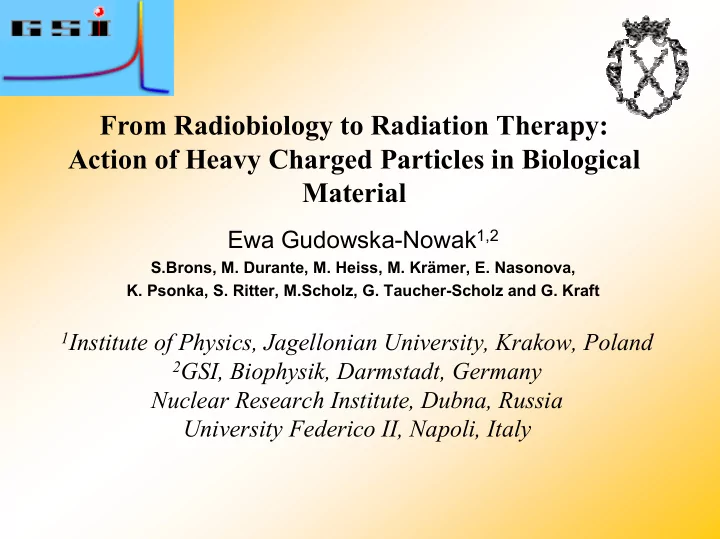

HCPBM HCPBM Lyon 2003 Lyon 2003 From Radiobiology to Radiation Therapy: Action of Heavy Charged Particles in Biological Material Ewa Gudowska-Nowak 1,2 S.Brons, M. Durante, M. Heiss, M. Krämer, E. Nasonova, K. Psonka, S. Ritter, M.Scholz, G. Taucher-Scholz and G. Kraft 1 Institute of Physics, Jagellonian University, Krakow, Poland 2 GSI, Biophysik, Darmstadt, Germany Nuclear Research Institute, Dubna, Russia University Federico II, Napoli, Italy
Challenges of biophysical research with heavy ions • Mechanisms of biological damage induced by densely ionizing radiation: cellular response, signal transduction, genetic mutation • Charged-particle cancer therapy • Radiation protection Radiation protection in long in long- -term term space space • missions missions ***Bevelac (Berkeley), GSI (Darmstadt), HIMAC (Chiba), AGS-BNL (Brookhaven)
• High and low LET radiations act differently on DNA (differing degrees of spatial clustering of ionizations!) • Number and size distribution of DNA fragments show a significant dependence on radiation quality • The effect can be attributed to the random distribution of radiation tracks and deterministic localisation of energy within the track
Lesion clustering (multiple damage sites MDS) occurs at various levels of chromatin organization A: Locally MDS B, C, D: Regionally MDS 30 nm chromatin fiber B. Rydberg, Acta Oncol., 2001.
• Krämer, Kraft, Radiat. Environ. Biophys., (1994) • Cucinotta, Nikjoo, Goodhead, Radiat. Environ. Biophys., (1999) • Scholz, Kraft , Radiat. Protec. Dosim., (1994) • Holley, Chatterjee, Radiat. Res., (1998)
p21 foci in human fibroblast nuclei traversed by Pb ions 207 Pb: 3.0 × 10 6 cm -2 X-rays: 10 Gy 0 h 10µm 1.5 h 15 min B. Jakob et al., Radiat Res., 2000.
Intracellular DSB induction and rejoining along the track of carbon particle beams Intact DNA 12 C LET: determines the frequency and complexity of clustered damage 190 MeV/u low LET: 20-30% of DSBs from 2 SSBs DNA fragments high LET: 80-90% of DSBs from 2 SSBs Heilmann J. et al., Int J Radiat Oncol., 1996.
Chromosomal aberrations in blood lymphocytes George et al., 2001 Simple reciprocal Complex exchanges Normal exchange involving involving chromosomes chromosome 5 1, 2, and 5
Ritter et al., Ritter et al., Initial damage and time-dependent IJRB, 2001 IJRB, 2001 repair: X-rays versus Ar -ions
Direct visualisation: AFM measurements Ni- ions Ni- ions E=3 . 5MeV/u, E=3 . 5MeV/u, LET=4120 LET=4120 keV/ µ m keV/ µ m plasmid DNA Φ X174 (5386 bp)
Brons et al. Brons et al. Radiat. Environ. Biophys., 2003 Radiat. Environ. Biophys., 2003 Microscopic Microscopic stochastic features stochastic features of the track: of the track: LEM (Local Effect LEM (Local Effect Model) Model)
Counting statistics and distribution of fragment lengths from the LEM (Local Effect Model) Distribution of Distribution of Distribution of Distribution of number of DSBs fragments’ lengths number of DSBs fragments’ lengths
Conclusions After high LET irradiation most DSBs is located in clusters corresponding to multiply damaged sites Even without detailed information on chromatin geometry, stochastic models can give predictions on the frequency distribution of damage (DSBs, PCC plus excess fragments...) Differences in the complexity of induced lesions can be traced back to the pattern of a local energy (dose) deposition
Conclusions • Cosmic radiation is one of the main problems for long-term space missions, particularly for the exploration of Mars • Necessity: to reduce uncertainty in risk estimates and to develop contermeasures • These tasks can be accomplished (within 10-20 years) by extensive biological experiments at Durante, 2003 Durante, 2003 accelerators using p and heavy ions at 0.1<E<10 GeV/n
•S. Ritter, E. Nasonova, E. Gudowska-Nowak M. Scholz and G. Kraft Aberrations in V79 Cells Analyzed in First and Second Post-irradiation Metaphases , Int. J. Radiat. Biol. 76 (2000) 149. .E. Gudowska-Nowak, S. Ritter, G. Taucher-Scholz, G. Kraft, Compound Poisson Processes and Clustered Damage of Radiation Induced DNA Double Strand Breaks , Acta Phys. Pol. 31 (2000) 1109. Recent publications •.E. Nasonova, S. Ritter, E. Gudowska-Nowak, G. Kraft, High-LET Induced Chromosomal Damage: Time Dependent Expression , Physica Medica 17 (2001) 198. •.E. Gudowska-Nowak, A. Kleczkowski, G. Kraft, E. Nasonova, S. Ritter, M. Scholz, Mathematical Models of Radiation Induced Mitotic Delay , Physica Medica, 17 (2001) 161. •.E. Nasonova, E. Gudowska-Nowak, S. Ritter and G. Kraft , Analysis of Ar Ion and X-ray Induced Chromatin Breakage and Repair in V79 Cells , Int. J. Radiat. Biol. 77 (2001) 59. •. S. Ritter, E. Nasonova, E. Gudowska-Nowak and G. Kraft Is high LET damage on chromosomes different from low LET damage? Proceedings of the 3rd Wolfberg Meeting on Molecular Biology, Ermatingen, Schweiz,1999 •.S. Ritter, E. Nasonova, E. Gudowska-Nowak and G. Kraft Mutation Expression in Chromosomes After Particle Irradiation GSI Annual Reports, Darmstadt, Germany 1999. •.S. Ritter, S. Berger, T. Gr ő sser, P. Hessel, G. Kraft, E. Nasonova, K. Ando, E. Gudowska-Nowak Quantification of high LET induced chromosome damage , GSI Annual Reports, Darmstadt, Germany 2000. •.S. Ritter, E. Nasonova and E. Gudowska-Nowak Effect of LET on the yield and quality of chromosomal damage in metaphase cells: a time-course study }, Int. J. Radiat. Biol. 78 (2002) 191. •.T. Gr ő sser, P. Hessel, S. Ritter, E. Nasonova, E. Gudowska-Nowak, Use of human lymphocytes for radiation risk assessment , GSI Annual Reports, 2001. •.R. Lee, T. Gr ő sser, P. Hessel, E. Nasonova, E.Gudowska-Nowak, S. Ritter, Analysis of the cell cycle progression of unirradiated and irradiated human lymphocytes , GSI Annual Reports, 2000. •.S. Brons, K. Psonka, M. Heiss, E. Gudowska-Nowak, G. Taucher-Scholz, Direct visualisation of heavy ion-induced DNA fragmentation by use of the Atomic Force Microscopy , Radiation Oncology, (2003) in press. Enlight Nanometer-scale Science Advanced Materials NANOSAM UJ
Energy localisation: the Bragg peak Energy localisation: the Bragg peak
Ni ions Ni ions Induction of double strand breaks (DSB) 3.5 MeV/u, 3.5 MeV/u, 4•10 8 p/cm 2 4•10 8 p/cm 2 N hit >1 N hit =1
Recommend
More recommend